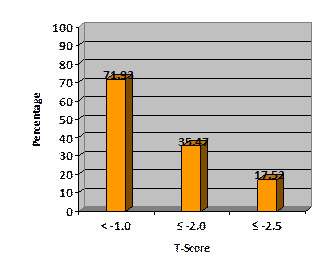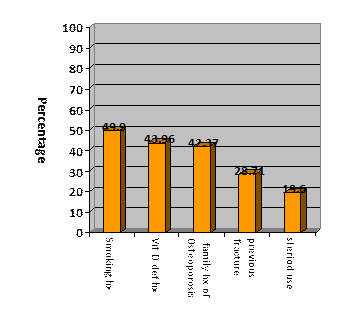Background/Purpose: Many younger women, < 65 years of age may have low bone mineral density (BMD) that remains undetected in clinical practice due to following Medicare age guidelines of 65 years and older for BMD test and other factors. Prevalence of low BMD is a growing public health issue in the population but these have not been well quantified in this younger age group of women. This study aims to describe prevalence of low BMD at a family health center in postmenopausal women younger than 65 years and identifying common risk factors noted in this age group.
Methods: Retrospective chart review was done of patients who had dual-energy x-ray absorptiometry (DXA) scan performed at family health center between Jan 2010 to May 2012, on Hologic® DXA machine. Postmenopausal women less than 65 years of age were included (amenorrhea ≥ 12 months). Patients who have been on osteoporosis medication therapy and used estrogen postmenopausal were also included in this study. The data of risk factors was collected from patient questionnaire present in medical charts. Patients were grouped into those with low T-score < -1.0, T-score ≤ -2.0, and T-score ≤ -2.5. T-scores of the spine (following the International Society for Clinical Densitometry guidelines), femoral neck, total hip, one-third radius (when available) was reviewed and from these the lowest T-score was used in the results.
Results: A total of 702 patient charts were reviewed. The age ranges from 30 to 64 years and average age of patients was 56.74 years. We found 71.93% of patients have T-score < -1.0, 35.47% of patients have T-score ≤ -2.0, and 17.52% of patients have T-score ≤ -2.5. The risk factors noted among T-score < -1.0 are summarized in figure-2 below and 88.51% were found to have at least 1 or more risk factors out of five.
Figure-1
This figure represents percentage of patients in a T-score group. (n=702)
Figure-2
This figure represents percentage of patients among T-score <-1.0 have this risk factors.(n=505)
Conclusion: The results show high prevalence of low BMD in postmenopausal women younger than age 65 years at this family health center. Although population prevalence cannot be calculated from this study, findings suggest that low BMD is fairly prevalent in this age group. A larger study would be needed to further evaluate low BMD in postmenopausal women younger than 65 years of age. If confirmed this should alarm clinicians to obtain BMD testing in women earlier than age 65 years and especially so in those who have the identified risk factors and to identify the younger age group women with undiagnosed osteoporosis.
Disclosure:
M. Vaishnani,
None;
F. T. Al-Ashkar,
None.
« Back to 2012 ACR/ARHP Annual Meeting
ACR Meeting Abstracts - https://acrabstracts.org/abstract/what-percentage-of-postmenopausal-women-younger-than-age-65-years-have-low-bone-mineral-density-at-a-family-health-center/


